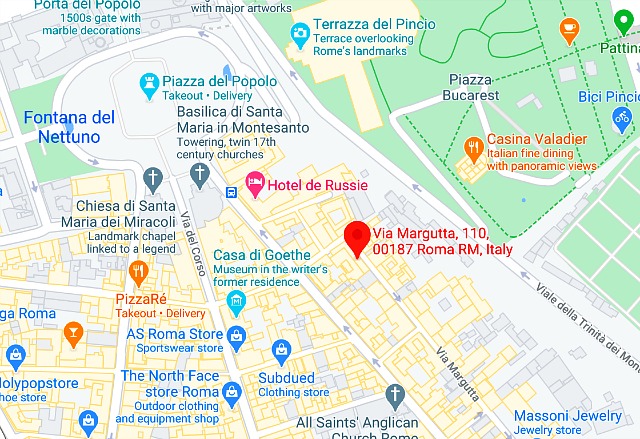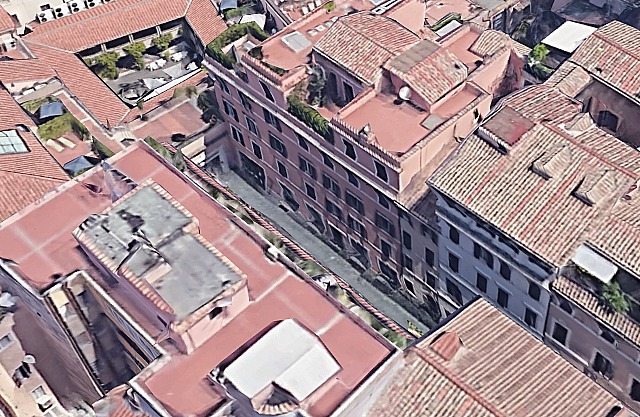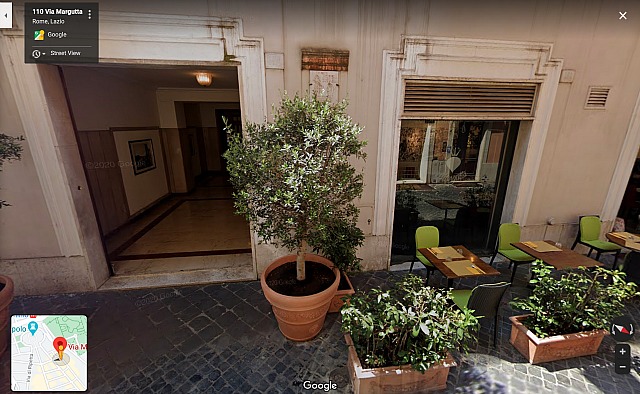Via Margutta is a narrow street in the center of Rome, southeast of Piazza del Popolo, not far from the Spanish steps. It was once a region for craftsmen, workshops and stables, but after it was featured in a scene from William Wyler‘s Roman Holiday (’53), Via Margutta became an exclusive neighborhood. It now hosts art galleries, restaurants, cafes.
Not so long ago I was visiting the Cannes Film Festival every year, and with that honor and luxury I had the option of visiting Rome (or Prague or Paris or you-name-it) from time to time. That life seems so obscure now, a faded memory, ether of the past. Will I ever stroll down the Via Margutta again? For the first time in 20 years, the answer is “maybe not.”
From “Rome’s Very Short Street With a Long, Magnificent History,” a Smithsonian piece (April 2015) by Jeff MacGregor:
“Via Margutta is a short street with a long history, three blocks going back 2,000 years. An oasis of quiet set between the teeming Piazza di Spagna and the Piazza del Popolo, lined with vining ivy and ocher stucco, cobblestones and window boxes, art galleries and artists’ studios, it is one of the most beautiful streets anywhere. Along the via’s three blocks, Roman street life achieves a languorous charm all its own.

“Roman Holiday is a love letter to love, and to Rome and to Audrey Hepburn and Gregory Peck. It launched America’s postwar tourist business to Italy, and that courtyard apartment is so charming and famous that film buffs from all over the world seek it even today, more than 60 years later. But it’s easy to miss, and when you find it, the door is almost always closed and locked.
“A few years later Federico Fellini personified a variation of that tabloid cynicism in the character Paparazzo in his own film La Dolce Vita, which is the opposite of a love story.
“Fellini lived at Via Margutta, 110. For decades he and his wife, actress Giulietta Masina, were fixtures in that colorful street. The marker is still at their apartment door. And this, more than anything, accounts for my interest in their corner of Rome. I’ve been an avid fan for many years.
“When not recreating the Via Veneto on Stage 5 at Cinecittà, or filming in the park across the Via Tuscolana from the studio, Fellini shot often in his own neighborhood. Once you know the streets around his home, you begin to recognize them in his movies. And in others.
“The maestro often drank his espresso around the corner at Bar Canova on the Piazza del Popolo by the twinned churches of Santa Maria—near the same spot he used in Roma and La Dolce Vita; and at which Woody Allen later filmed the scene where the newlywed wife loses her phone in To Rome With Love.
“Masina and Fellini are gone now, but if you know where to look, and book the right hotel, you can still see the awnings and the shutters and the ornamental fruit trees on what used to be their terrace. Theirs is the best-known house on the street.”
Producer pally: “I lived on Via Margutta with [a friend]. We were two doors down from the Roman Holiday apartment. We could see their terrace from our terrace. It was all quite surreal and magical. There’s a scene when Peck and Hepburn walk out on their terrace. And for a few seconds you can see our studio. Down the street was the Hotel de Russie with one of the most luxurious gardens in Rome. What a great place to eat! We lived there for a while the studio was being built. And up the street were the Piazza de Popolo twin churches, loaded with Renaissance painters.”


